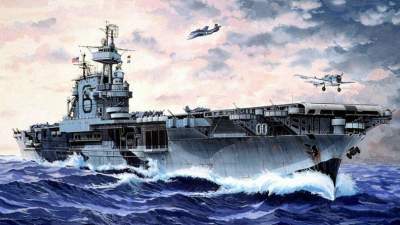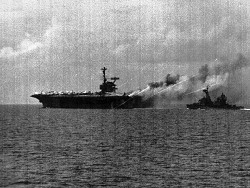
One of the most debated issues in military fiction is the survivability of aircraft carriers. First and foremost, of course, nuclear supervisores U.S. Navy – the favorite targets for the authors of technothrillers. Such interest is quite understandable: these 100,000-tonne giants, after all, are the largest in the history of military ships, which have no analogues outside of the United States Navy, and they embody the basis of the combat power of the modern Navy.
Almost every techno-Thriller, describing the Soviet-American conflict from 1960 to the 1980s, includes the scene of the attack the Soviet MRA on American nuclear aircraft carrier. Which – depending on the political affiliation of the author concluded that either the carrier erupts like a match to the cries of horror dying team, or an aircraft carrier heroically overcomes the cries of horror of the pilots shoot down dozens To NIS. Usually, however, these scenes are very far from reality.
So the question is: how resilient carrier?
As textbook examples of the vulnerability of modern aircraft carriers usually result in disastrous fires on the USS “Forrestal” (1967) and USS enterprise (1969). In both cases, the ships had suffered significant damage due to the detonation of ammunition and ignition of fuel on the flight deck, accompanied by numerous victims and a long repair.
However, whether these examples are fully representative?
In both cases, the cause of the accident was the inadvertent triggering of Nursi during equipment of aircraft for sorties. Ie occurred a force majeure, unexpected incident, and the team has not completely had the time for any action.
Identical whether it is a situation of a hostile attack? Only if the ship is taken completely by surprise, the enemy was discovered in a matter of seconds from the ship, and the team simply does not have time to do anything – i.e. only in the Worst Possible Situation. There is no doubt that this is the worst situation possible, but we must also recognize that it is highly unlikely. In a normal situation, the ship still sees the enemy’s attack for some time before actually falling, and has some reserve of time for response.
That may take the carrier, with a small warning?
The fire on the aircraft carrier “Forrestal.”
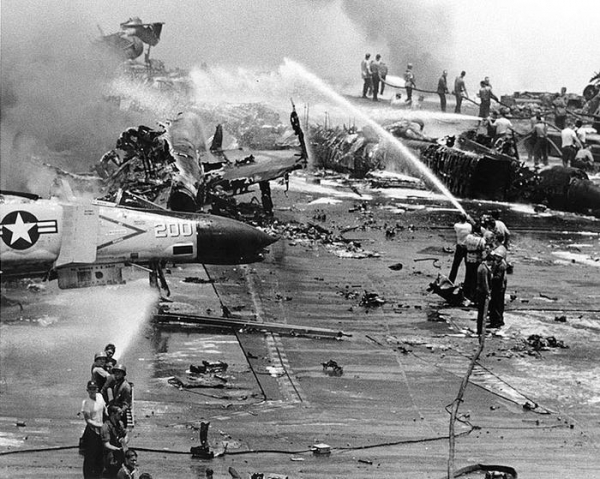
In the first place – not to meet the enemy’s attack with loaded planes on the decks. Severe damage to the “enterprise” and “Forrestal” was caused primarily by the fact that at the time of the accident both ships were preparing air group to fly, and their flight decks were standing in a variety equipped and fuelled aircraft. It is the curb explosions of bombs and the ignition of spilled fuel from the tanks of aircraft have become the main cause of loss and destruction.
If the carrier has at least a 5-10 minute warning of the impending threat, his team:
– Overlaps and bleeds the fuel line, thereby eliminating the risk of spread on them of a fire or leakage of fuel gases, threatens to burst.
– Munitions and external fuel tanks either be removed to the cellar, or (if short of time) just dumped over the side of the trucks.
– Ready to start the aircraft urgently run. From seasoned but not ready to fly urgently drained the fuel (if time is not enough, these machines can be extra thrown overboard – of course, to lose a fighter for tens of millions of hate, but leave a bomb on the flight deck even less nice). Unmade machines are cleaned in a hangar.
– Locked ballistic bulkheads, blast doors are closed and operate all fire-fighting equipment and gear.
Thus, ideally, to the point of actually hitting the aircraft carrier, the situation of a large fire, with secondary detonations excluded: on the flight deck there is neither fuel nor ammunition, and all fire-fighting equipment are in complete readiness. Of course, the ideal is not always achievable in a real situation; but in any case, at the time of contact on the deck will be facing a series of planes with full tanks and stacks of bombs.
If the carrier has more than a half-hour warning, then, as a rule, the question is already “will be able to survive at least some of the attackers”, once under the blows of his air group and escort ships.
Naturally, the stock of time available to the carrier, depends entirely on how early you will receive a warning about the attack. Regiment naval missile will be detected at greater distances. Starting with the submarine anti-ship missiles on the smaller. In General, if detection systems squadron – ie, AWACS aircraft, helicopters, antisubmarine patrol, escort ships and means of RER – work properly, avoiding critical errors, the 10-minute warning of an aircraft carrier, as a General rule.
Survivability of an aircraft carrier.
The first impression of supervisora – it’s big. It is very large – 330 meters long and 45 meters wide at the flight deck. Usually, the size of supervisora interpreted as a sign of its vulnerability; in practice, they are one of the key elements of its vitality.
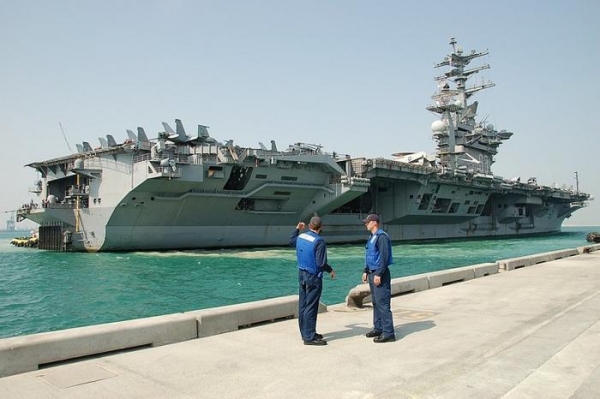
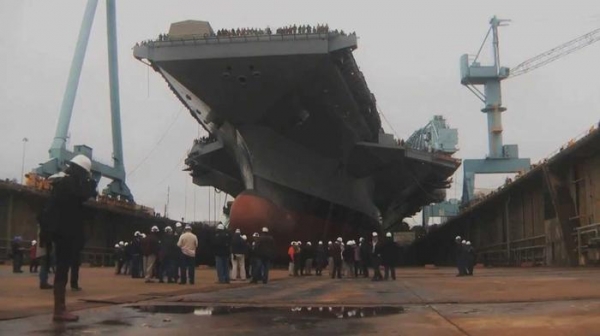
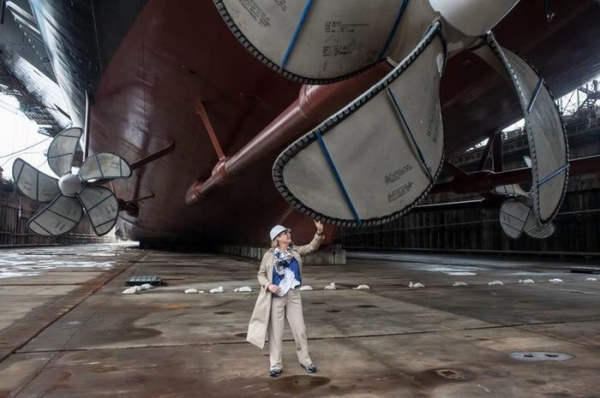
In the vast body of supervisora, all vital parts are duplicated and separated by the maximum possible distance from each other. Every vital system is represented in more than one instance. Each instance of each vital system removed from the other at such a distance, which makes the probability of their simultaneous damage with one hit negligible.
Thus, to disable the carrier single hit (not considering nuclear weapons) is hardly possible. Although the ship does not carry the traditional appearance of the reservation, the linear dimensions virtually eliminate the spread of damaging factors of conventional weapons on such a large distance.
At the same time, we cannot say that the carrier is just too “soft” goal. The thickness of the outer steel plating of the carrier reaches 1-1,5 cm, inner longitudinal bulkheads up to 2-2,5 cm. Made of high strength steel plates plating play an important role in ensuring the survivability of the ship: they inhibit the spread of shrapnel and shock wave, localizing the damage.
To thick the hull and bulkheads added to the local reservation ballistic – Kevlar plates with a thickness up to 64 mm can be laid on top of the reactor compartments and cellars of ammunition. Of course, these plates are not designed to withstand direct hits of rockets and missiles, but they (in combination with a steel lining) is able to effectively contain the fragments. As a result, the penetration of a missile or bomb inside the case, its devastating effect is localized within the affected and neighbouring compartment; the pieces do not stitch through the ship, destroying everything in its path, and do not pass the underwater part of the hull. Damage to be localized in compartments close to the point of impact.
Consider supervisees more details:
(WARNING: this scheme is not reliable and is only used for General idea)
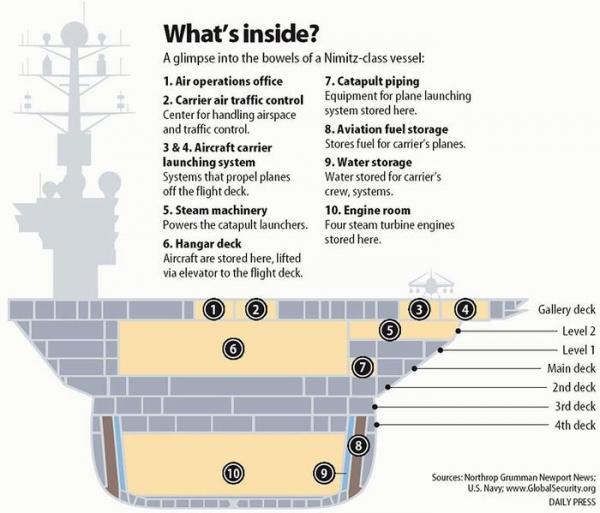
Deck systems:
All deck systems of an aircraft carrier And dubbing, and B are distributed so that one hit can’t get them all down. Fortunately, the size of the deck allow. A large part directly communicating with the flight deck engines – catapults, arresting gear mechanisms – mounted on the gallery deck located between the flight and hangar roof.
The layout of the flight deck of the aircraft carrier CV-60 Saratoga, type “Forrestal”
WARNING: the text describes the aircraft carrier type “Nimitz”, the scheme is given for General information only drawings of an older aircraft carrier.
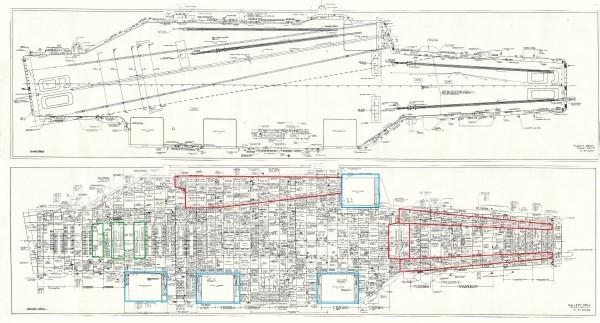
The layout of the flight deck of the aircraft carrier CV-68 “Nimitz”, type “Nimitz”

Catapult (highlighted in red): modern American aircraft carriers have four catapults, distributed in two blocks, one in front of the flight deck, the other on the corner of the flight deck. Thus the working parts of both units of catapults exploded on the gallery deck for a distance of over 50 meters.
This separation, and ballistic bulkheads ensure that no single hit will not incapacitate all four catapults simultaneously. In the worst case (hit in return arrangements) will be disabled one pair of catapults; most likely, one hit will be taken out of a catapult from a couple.
It should also be noted that even complete failure of the catapults of the aircraft carrier does NOT mean the end of runway operations. Any aircraft with a thrust-weight ratio close to unity, will be able to take off from the ship just by Jogging on the deck (with fixing the chassis to the set engine power). For example, the F/A-18E/F “Super Hornet” in the simplified equipment and with 50% fuel it has a thrust-weight ratio close to 1.1, which allows him to take off from the deck without using a catapult. Aircraft with a lower thrust – like AWACS E-2C “Hawkeye” – will also be able to perform takeoffs, when using the launch of JATO boosters.
The arresting gear (highlighted in green): modern aircraft carriers have four arresting gear, again divided into two blocks. Both units removed from each other and isolated transverse bulkheads, so that the destruction of one affects the other. It should also be noted that the superstructure design of arresting gear (i.e. ropes) is easily replaceable; furthermore, even the complete failure of the arresting gear does not hurt to ground the aircraft “emergency” method with the use of landing nets, barriers.
Samoletiki (highlighted in blue): Supervisory are four of them (on passing test Ford – three) distributed over the edges of the flight deck. Three located on the starboard side, one on the left. Samoletostroenie spaced at a distance more than 20 meters from each other (except the front pair on the Board right before the “island”) and also can’t be disabled at the same time with one hit.
Samolyotov hatches in the sides of the closed dual blast proof doors with a wide gap between them. For additional protection platform samoletostroenie.
How able to withstand damage the deck of an aircraft carrier?
In the case of fire on the “Forrestal” on the flight deck of the aircraft carrier had happened of detonation:
– Sixteen (16) high-explosive bombs AN-M65 (453-kg each)
– Four (4) M117 high-explosive bombs (340-kg)
– Eight (8) high-explosive bombs Mk-82 (225-kg)
– According to estimates, due to degradation of the bombs used in the unstable compounds Composition B, some of the detonation was stronger than expected in theory.
Thus, on the deck of the aircraft carrier worked a number of ammunition, comparable in strength to the combat of the heavy anti-ship missiles.
In the case of fire on the Enterprise, on the flight deck of the aircraft carrier had happened of detonation:
– Four (4) nurs Zuni (5-kg warhead each)
Six (6) high-explosive bombs Mk-83 (225-kg each)
A full tanker with 6000 gallons of jet fuel
However, three of the Mk-83 detonated simultaneously. Them burst (with total capacity close to the explosion of the warhead of heavy RCC), punched in the flight deck of the aircraft carrier size hole 6×5. 5 meters. A total score, on the deck of an aircraft carrier occurred on 18 detonations, of which 8 were accompanied by damage to the deck.
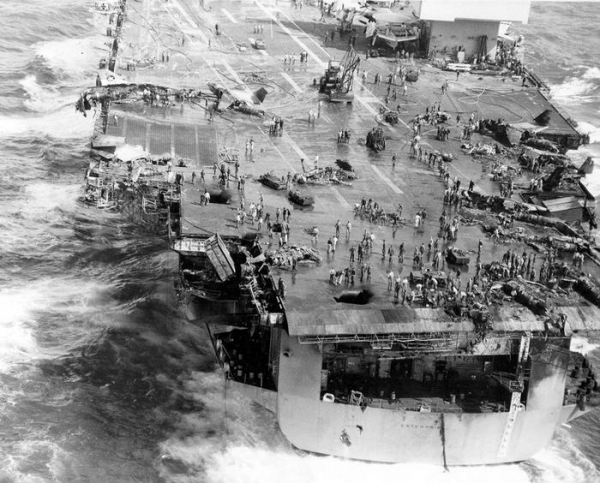
Nevertheless, as can be seen, damage to the flight deck was And is a relatively small (in comparison with its size), and B – localized. Even the most powerful explosions led to the formation of holes of relatively small dimensions, comparable with the dimensions of the deck. None of the punched holes in itself would not be a fundamental problem for the implementation of runway operations – although, of course, would add headaches to the managers and could be easily repaired in a very short time, cutting blowtorch damaged edges of the hole and the top of the temporary steel decking.
Overall, the experience of the fires of the 1960s clearly shows, trying to bring the carrier down, destroying its flight deck is not the best idea. The number of hits required for this exceeds reasonable limits.
Try to get through this (rocket) deeper.
Hangar:
The hangar of the aircraft carrier is separated from the flight deck, gallery deck, where you are mechanisms of catapults, arresting gear, and offices. If the missile struck and the flight and gallery deck (or hit the Board at an altitude of 20-30 meters above the water), it is with high degree of probability detonate either in the hangar or in one of the compartments next to it.
Hangar supervisora three-section, is divided into three parts sliding explosion-proof bulkheads:
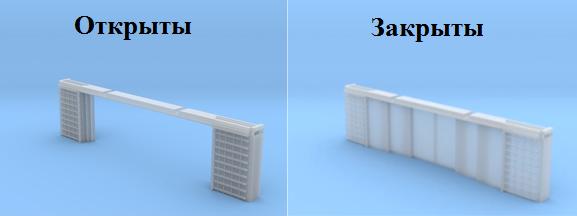
Explosion-proof bulkheads localize the propagation of the shock wave, shrapnel and burning rocket fuel, limiting the destruction of one section of the hangar. Sources of secondary detonations and fires in the hangar no: disastrous Japanese experience of the Second World made it clear that to keep fueled and loaded aircraft in the hangar of an aircraft carrier is unacceptable under any circumstances. Therefore, all that is normally located in the hangar is an empty aircraft that do not “add kerosene to the fire”. In certain situations the gear of the aircraft in the hangar is allowed, but only with the installation of weapons, has a long “warm up” in case of fire. Ie, for example, bombs that do not detonate immediately, and will last long enough to fire service had to intervene.
Thus, to break into the hangar deck of an aircraft carrier missile can damage or destroy the contents of only one section of the hangar. At full occupancy of the hangar, it will mean the loss of damaged or destroyed about one third of the carrier air group. Automatic (duplicated) the foam-extinguishing system allows the hangar immediately after the explosion to isolate the source of the ignition, and eliminate the spread of fire through the broken fragments of the holes.
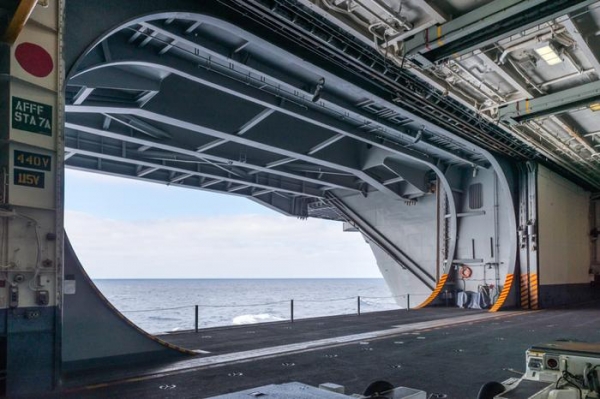
Stockpiles of ammunition
System for feeding ammunition from the arsenals to the flight deck is divided into two stages, to the transfer station on the second deck. In the first stage, elevators delivering ammunition from cellars to the Assembly room on the second deck; there is ammunition equipped, check and served to the flight deck or using a special Elevator or by using a conventional on-Board samoletostroenie. In this Assembly room made possible further from the hull under the overhang of the flight deck, in fact, “hanging” above the sea.
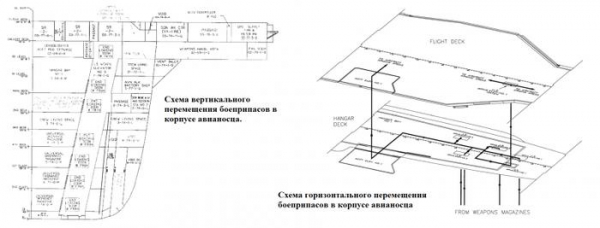
This “split” design ensures that the design of the ship there is no “direct” corridor, which effects could sneak into the cellar of ammunition.
Yourself cellar locked up as securely as possible: in the underwater part of the ship, below the waterline and is divided into 32 independent compartment (also for reasons of localization of possible damage). For ballistic protection, the cellar and the engine room is covered with 64 mm Kevlar pronephroi; although she is not able to stop it hit a missile, it can effectively contain the spread of debris down to a vital part of the ship.
The survival of the ship is also provided and the design of ammunition. After the fires of the 1960s, the U.S. Navy formed a special Commission to study the fire resistance of the ammunition used in combat vehicles. As a result, we formulated the sustainability of munitions to heat (from fires), concussion (shock wave) penetration by shrapnel. The aim was to guarantee that even a direct hit in the cellar of ammunition – ammunition carrier NOT detonate immediately, and will be given time to work and fire protection systems (if necessary) mechanisms of flooding.
All ammunition was empirically generated tables “warm up”, defining the minimum time in which a particular munition may detonate when heated (e.g. in a fire). Weapons small time of warming – missiles and nurs – under any circumstances is not allowed to load to the hangar deck, while a weapon with a long warm – bombs and torpedoes – can be in emergency need, installed on the aircraft to the hangar deck. Any ammunition used on ships that are certified for “warm-up”, the effects of shock waves and penetration by fragments. Even in the worst possible situation, ammunition should leave enough time for the intervention of the fire services of the carrier.
Is it possible, in principle, a direct hit in the cellar of an aircraft carrier? In theory, perhaps, but not too likely. As mentioned above, the cellar of an aircraft carrier are in the underwater part of the ship: that is, the warhead anti-ship missiles will have to overcome 6 to 8 decks (as well as many intermediate bulkheads and structures) to have a chance to get into the cellar.
Polibromirovannyie and standard high-explosive warhead anti-ship missiles even the supersonic – do not have this ability; specially designed penetrating warhead probably can do it. Interestingly, the Soviet heavy anti-ship missiles typically had cumulative funnel bottom high-explosive warhead in the hope that the jet stream will be able to penetrate deep into the body of the affected ship, and, with luck, something will hurt.
Aviation fuel
Aviation fuel is the main source of fire hazard on Board the aircraft carrier. Modern U.S. military aircraft use only aircraft fuel JP-5. Although it is less energetically favorable than the more modern JP-8, and all naval aircraft can refuel as JP-5 and JP-8, but old fuel JP-5 has a 40% higher ignition temperature and is more secure when used on aircraft carriers – it can not so easily ignited in case of an accidental spill.
On the flight deck of the aircraft carrier placed 14 fueling sites that can be used as fuel for planes, and for emergency pumping of fuel. 6-7 (depending on specific vehicle), petrol of nodes placed on the hangar deck, and mainly used for emergency pumping of fuel to be sent to the hangar of the aircraft. It takes about ten minutes to completely empty the tanks fully fueled F/A-18E using the ship lines, or about fifteen minutes by using a portable hose.
On Board the nuclear-powered aircraft carrier with the aircraft fuel tanks located in the torpedo Buli its underwater part (non-atomic, this place is usually busy with his own fuel, which negatively affects survivability). So they are most removed from other vital parts of the ship, and is surrounded by outside water. To ensure fire safety, the fuel tanks are maintained in an oxygen-free environment, surrounded by compartments filled with nitrogen. In the event of leakage from the tanks, a pair of resulting fuel will not be able to form an explosive mixture or to be tightened inside the hull.
Powerplant
The power plant of the aircraft carriers type “Nimitz” is dispersed and layered. Reactor and turbine compartments alternate (from bow to stern: the reactor-turbine-reactor-turbine) and separated from each other by two watertight bulkheads and intermediate compartments each. Such an arrangement ensures the preservation of efficiency of the power plant, if a separate compartment is affected by contact with enemy weapons or flooded.
As the cellar of ammunition, reactor compartments of an aircraft carrier covered 64 mm Kevlar plates that protect from falling debris. Unfortunately, I do not know exactly the emergency measures taken to muting reactors in the event of battle damage. It is known that the ship’s reactors since the 1970s work on the principle of “fail safe”; i.e., the reactor core is partly filled with water as a neutron moderator and water is continuously pumped out by the pumps. In case of failure of the reactor (or manual shut off of the pump), the reactor core is flooded completely due to the cessation of pumping, and reactor emergency stops.
Overall, I think the probability of a catastrophic nuclear accident specifically for the US Navy is the smallest, due to the extremely high level of training of reactor staff and safety of reactor units, provided also the famous Admiral Rickover.
It should be noted that a nuclear power plant brings benefits in terms of the survivability of nuclear aircraft carriers in comparison with steam boilers. The main advantage of nuclear power plants is the lack of need for the fuel tanks – which allows to distribute the internal volume of the body more efficient, without taking their thousands of tons of fuel oil.
Underwater protection
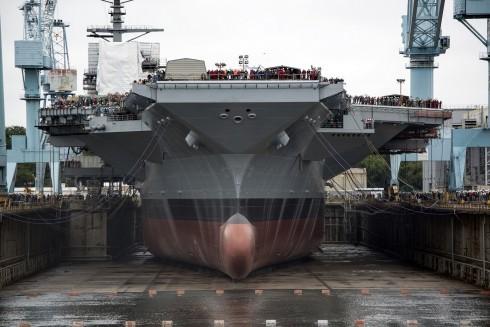
The thickness of the torpedo protection Supervisori currently reaches 6 meters. According to reports, it is based on classic “American” three-chamber scheme: enhancing chamber on the outer plating, Luggage acquisition (tanks with jet fuel) in city centre extension, before the main watertight bulkhead. According to some, the expansion of torpedo protection of aircraft carrier uses a synthetic filler, effectively absorbs the residual shock wave energy and limiting leaks. According to available data, this protection has to withstand the contact explosion of a torpedo with a 300 kg warhead – such as in most parts of the Soviet 533 mm torpedoes.
Blast protection underneath the vehicle is provided by a double bottom with a thickness of about 2.5-3 meters, and reinforced keel. Similarly, it is designed for non-contact undermining the 300 kg warhead. Case carriers degauss to neutralize the action of the magnetic Fuze; there are suggestions that the ships can also use the system setting magnetic interference, causing premature triggering of the fuses.
PTZ compartments in the diagram of the lower decks of the aircraft carrier CV-60 Saratoga, type “Forrestal”

The hull is divided into a series of watertight compartments twenty-three transverse and four longitudinal bulkheads, providing the buoyancy of the ship in the event of significant battle damage. (For comparison, the same number of watertight compartments had battleships type “Yamato” – not that they showed themselves invulnerable, of course…). A single hit by a torpedo even managed to break through the torpedo protection and flood compartment is thus not fundamentally threaten the survivability of the ship.
Nuclear weapons
The aircraft carrier “Ronald Reagan” performs educational flush radioactive fallout from the deck.
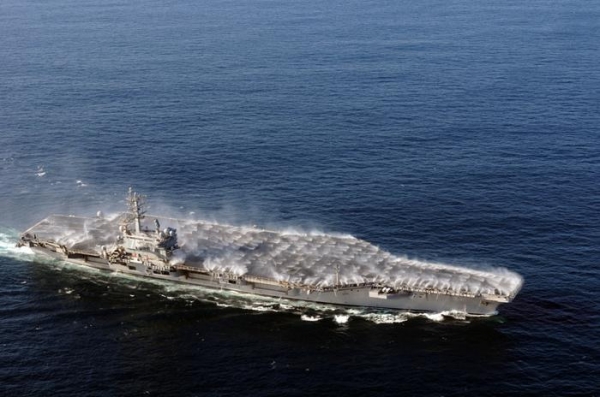
Finally, it is necessary to mention such a “popular” solution to how to attack aircraft carriers with missiles with nuclear warheads.
In a sense, this is the right approach. Nuclear weapons eliminates the difference in the security of ships, a direct hit by a nuclear warhead is guaranteed to destroy any warship, even though supervisees, though futuristic super-mega-combat platform with a displacement of one million tons.
On the other hand, non-direct hit by a nuclear warhead, the ship is quite able to withstand. Modern aircraft carriers are highly resistant to the damaging effects of nuclear weapons. Calculations the 1950s showed that the carrier can withstand overpressure in the shock wave front up to 30 psi (pounds per square inch) without critical damages. For modern supervisores built based on the experience of nuclear weapon tests, these figures can probably be increased to 35-45 psi. Ie this means that to guarantee the destruction of supervisora need to blow up a nuclear warhead, for example, 500 kilotons (referred to in most sources of power special warhead for RCC P-700 “Granit”) at a distance less than 1.5 miles away. This is slightly different from a direct hit.
The stability of the carrier to the shock wave and concussion is provided by the strength of the structure, partitioning compartments (tight bulkhead is designed to withstand the overpressure and not to let it inside). All warships of the U.S. Navy before adopting must pass the “shock test” on the ability to withstand without failure of the concussion and shock wave in the water column.
The shock test of the USS “Gerald R. Ford”
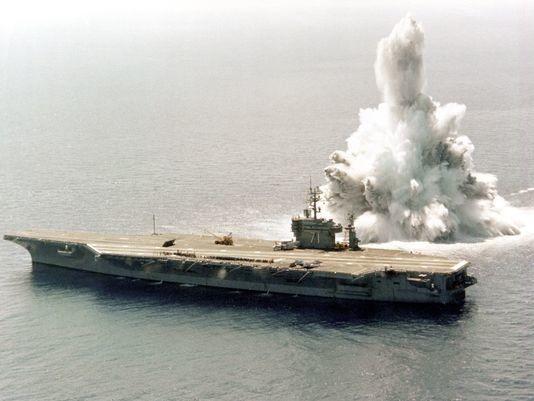
You should also consider that the flat deck of an aircraft carrier and a minimum of add-ins in General provide good stability to the action of the shock wave. Of course, everything is on deck to be thrown overboard and the superstructure-the island will get heavy damage… but it is not vital for the functioning of the ship. Most vulnerable to the shock waves elements – side samoletostroenie, but the double blast doors to limit damage.
Conclusion
So, how tenacious carriers? Undoubtedly, they are not invulnerable and with due diligence and a certain amount of luck, any ship can be put on the bottom. But we should recognize that that the aircraft carrier is MUCH harder than any other warship of the present day. Its size, the dispersal of the vital parts and the internal division into compartments allows supervenes to withstand damage able to send it to the bottom of almost any other ship.
My personal table is the survival of the carriers (of course, based only on personal assumptions!) looks like this:
– 1-2 hit heavy RCC (warhead weight up to 500 kg) – ship restores full efficiency in a short time. At least half of the catapults, arresting gear and samolyotov functioning. Lost destroyed or damaged about 1/3 of the group.
3-4 hit heavy RCC – ship retains a minimal combat capability. Within a few hours it is possible to recover the possibility of conducting air operations for at least the mileage of aircraft on the deck. At least half of the power plant operational. Lost from half to 2/3 of the group.
– 5-6 hits heavy RCC – ship is unable to restore the combat capability of their own efforts. Flight operations extremely difficult or impossible (excluding the helicopter). The possible loss of ship speed due to the silencing of reactors, flooding parts of the cellars of ammunition. Possible radiation leakage if the ship is really lucky.
It should be noted that even badly broken to the topside of the carrier is unlikely to sink. Having no underwater damage, a ship that size could stay afloat and with extensive damage to the hull and superstructures. Before the water enters the compartments of the carrier to the bottom will not go.
The sinking of the aircraft carrier underwater damage is also not an easy task. Given the power of torpedo protection carrier probably will require getting at least 8-10 torpedoes caliber of 533 mm in order to guarantee incapacitate him. Larger torpedoes (like now is not the armament of the 650-mm Soviet “Whales”) are likely to be more effective, but just as a single hit will not be fatal, or even significantly dangerous for your carrier. Like a landmine.
Direct hit of a nuclear warhead, of course, will destroy an aircraft carrier. However, he close the gap with a high degree of probability will survive, and keep fighting capacity. It should also be noted that the use of nuclear battlefield weapons – that’s NOT what love strategy. Tactical nuclear weapons introduces a strong element of unpredictability in tactics and strategy; making long-term planning impossible and absolutely not a fact that strengthens the position of the hand, began first to apply it. Again, to play in tactical nuclear weapons can both sides, and nuclear warheads can be placed not only on anti-ship, but anti-aircraft missiles.
In General – some practical advice the authors of technothrillers. Do not expect that attacked the aircraft carrier quickly fail. If you need to quickly and effectively bring the carrier out of action, prescribe a completely surprise attack with minimum warning time – but remember that such a – is A single chance (i.e., do not expect that it will be able to repeat), and B – works both ways (i.e. don’t forget to provide your opponent the opportunity to do something to catch him off guard and revealing to pulverize). Remember: you need a lot of hits to bring down an aircraft carrier (and he is not going to just here to allow you to do it).

